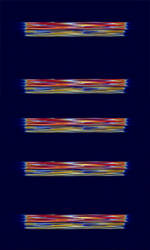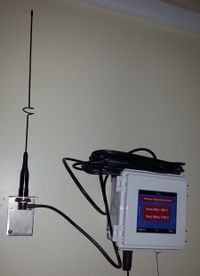Wireless Temperature Sensor
 | |
|---|---|
| Frequencies | 434 MHz |
| Frequency Range | 434 MHz - 434 MHz |
| Mode | FM |
| Modulation | CSS |
| ACF | — |
| Emission Designator | — |
| Bandwidth | 150 kHz |
| Location | Australia |
| Short Description | The freezer temperature is requested by a master at regular intervals, and the slave attached to a freezer responds. The communication format appears to be a variant of chirp spread spectrum, (although the spectrum it consumes is quite narrow at ~150 kHz). |
| I/Q Raw Recording | Download file |
| Audio Sample | |
A master sends out requests to individual freezer telemetry units and the slave at the freezer responds with the temperature information. The communication format appears to be a variant of chirp spread spectrum, (although the spectrum it consumes is quite narrow at ~150 kHzKiloHertz (kHz) 10^3 Hz). The signal can be observed by FMFrequency Modulation demodulation where the rising or falling chirp can be seen along with the abrupt changes in frequency. The image below shows an FMFrequency Modulation demodulated radio capture. The signal in blue is the master sending a request to a slave, black is background noise and red is the response from the slave.
Basically, this is a variant of LoRa modulation, perhaps the page needs updating, as similar digital signals can be observed in many other situations.


